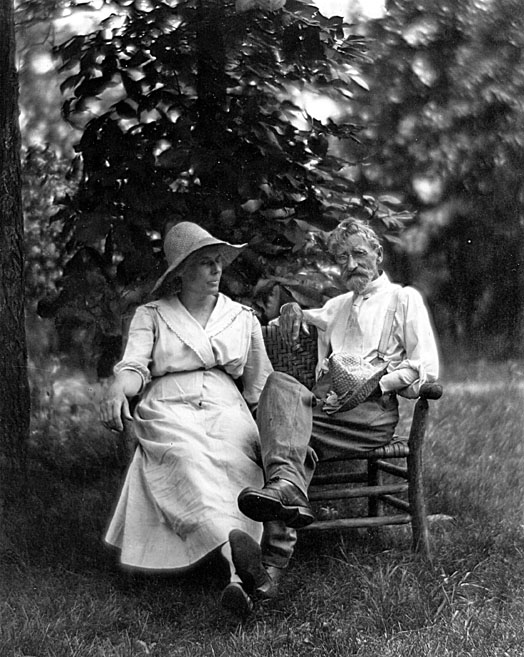By 1907, Theodore Clement Steele (1847-1926) was a well-known regional painter, sought after in Indianapolis and Chicago for his portraiture, and admired for the work in his exhibitions. But Steele had recently discovered and been inspired by the hills of Brown County, and he began plans to build a home and studio high on top of a hill and pursue “my life work . . . under the blue dome of heaven when the bugle notes of color are sounding.” Steele wrote these words to Selma Neubacher (1870-1945), who was soon to become his second wife and share his life in the home they would call the House of the Singing Winds.
During the spring and summer of 1907, Steele supervised construction of the house, a difficult task given the isolation of the area. The couple was married on August 9 and began their life together in their new, and at first somewhat primitive, home. In the memoir she wrote about her life with the man she called “the painter,” Selma commented honestly but uncomplainingly about the difficulties of their early years in the hills. The nearest grocery store (in Bloomington) was a day’s journey there and back—and Selma coped for months of their first year in Brown County with no cistern for water.
In the spring of 1908, after wintering in Indianapolis, Selma began planning and planting gardens—a pastime that would become her passion and her own artistic contribution to the House of the Singing Winds. Selma’s flower and food gardens gradually spread across the acres on the top of the hill. She ordered and read books on scientific gardening – she found out which flowers and vegetables would grow on the windy hilltop and not wash away in the spring rains. She covered the area around the expanding house (which eventually also included a large, separate studio) with a riot of color, captured by her husband in several paintings, among them the beautiful and popular Selma in the Garden.
The couple spent more and more of each year in their beloved home, even as Steele traveled to paint commissioned works and to exhibitions and gallery showings of his works. As roads began to improve by the early 1920s, the practical Selma urged her husband to buy a car, and she became the self-designated chauffeur. T. C. Steele died in 1926; in 1940 Selma wrote her memoir, dying five years later, in 1945.
Today the T. C. Steele State Historic Site comprises the couple’s home, the painter’s studio, and the surrounding acreage—the Selma N. Steele State Nature Preserve.
Source: Selma N. Steele, Theodore L. Steele, Wilbur D. Peat, The Life and Work of T. C. Steele: The House of the Singing Winds (1966)
A Moment of Indiana History is a production of WFIU Public Radio in partnership with the Indiana Public Broadcasting Stations. Research support comes from Indiana Magazine of History published by the Indiana University Department of History.























